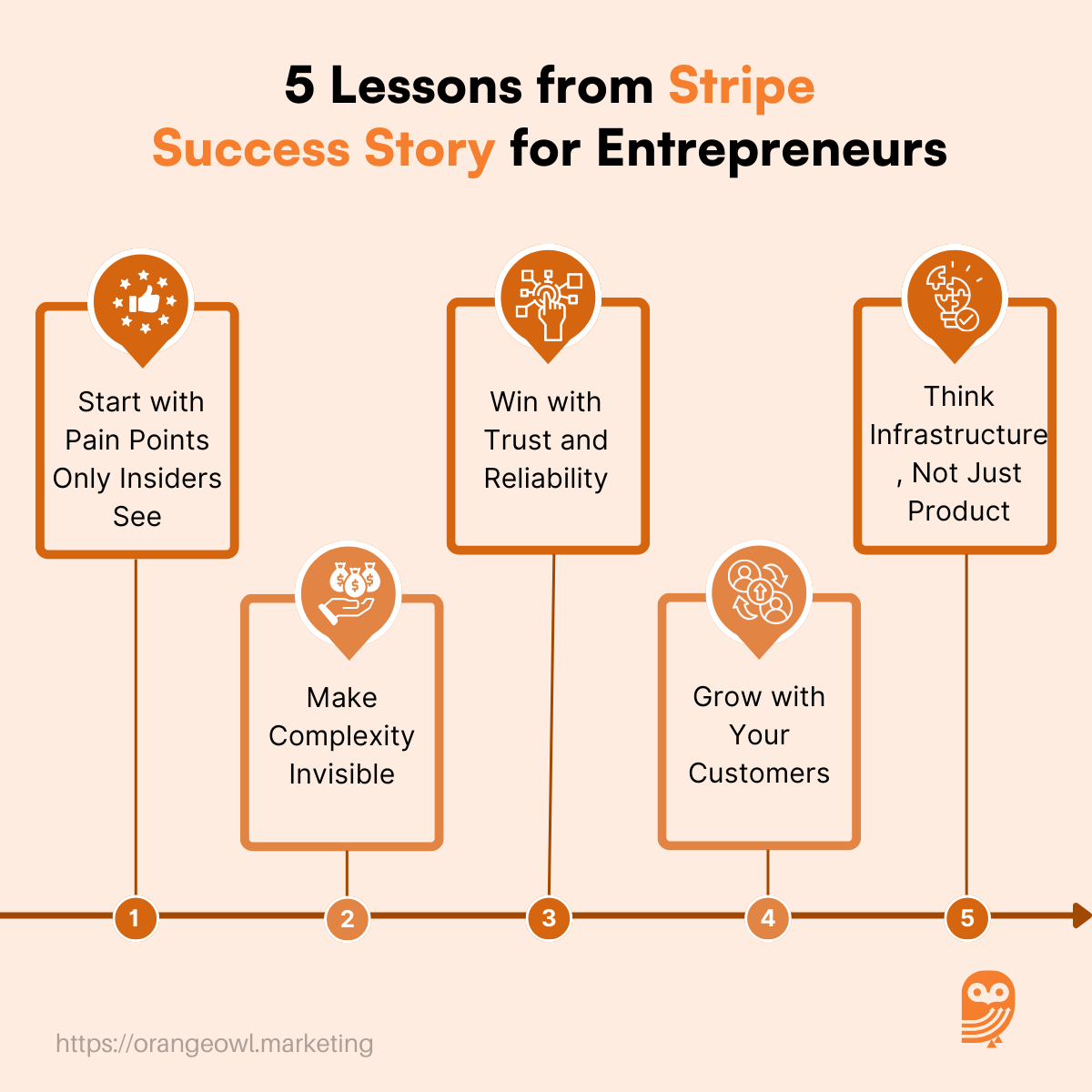Stripe Success Story: 5 Key Lessons for Every Entrepreneurs
Vivek Goel
August 19, 2025

Table of Contents
Introduction
In today’s global digital economy, Stripe has become the invisible backbone powering millions of online businesses. As of February 2025, Stripe was valued at $91.5 billion in a tender offer providing liquidity to employees and investors—just shy of its 2021 peak of $95 billion.
Founded in 2010 by Irish brothers Patrick and John Collison, Stripe’s mission was simple but ambitious: increase the GDP of the internet. At a time when setting up online payments was painfully complex, Stripe introduced a developer-friendly API that enabled startups, SMBs, and enterprises to accept payments with just a few lines of code.
From powering startups like Shopify, Lyft, and Instacart in their early days to serving global giants such as Amazon, Stripe has established itself as the foundational infrastructure layer of internet commerce. It now processes trillions of dollars in payment volume annually and deeply influences how businesses transact online.
Origin Story
The Collison brothers, both prodigious coders from Ireland, had already sold their first startup, Auctomatic, as teenagers. But in Silicon Valley, they noticed a recurring frustration among their peers: accepting payments online was unnecessarily hard. Banks were bureaucratic, gateways were outdated, and integration required months of paperwork and engineering.
The idea behind Stripe was radical in its simplicity: make payments a service that developers could plug into in minutes, not months. In 2010, Stripe launched in private beta, instantly winning over startups with its clean APIs and developer-first philosophy.
The early champions included Elon Musk (via SpaceX/PayPal networks) and venture firms like Sequoia Capital, who saw Stripe as the modern answer to the internet’s financial plumbing problem. By 2011, Stripe was out of beta and processing payments for fast-scaling startups — embedding itself into the DNA of Silicon Valley’s next wave of unicorns.
“Payments were a mess. We didn’t want people to have to become financial experts just to sell something online.” — John Collison, Co-founder, Stripe
Business Landscape and Challenges
When Stripe entered fintech, PayPal and legacy gateways like Authorize.Net already dominated online payments. But these systems were clunky, hard to integrate, and built for an earlier era of e-commerce.
Stripe faced multiple challenges:
- Regulatory complexity: Expanding globally meant dealing with a patchwork of banking rules, compliance laws, and anti-fraud systems.
- Building trust: Convincing startups and enterprises to handle money through a little-known startup.
- Reliability & scale: Payments is a “zero tolerance” industry — a few seconds of downtime could cost millions.
- Competition: Giants like PayPal, Square, and Adyen were established and well-funded.
Yet Stripe’s developer-first DNA turned these challenges into opportunities. By obsessing over APIs, documentation, and reliability, Stripe became beloved by engineers — the very people deciding which payment infrastructure to adopt.
Growth Strategies
Stripe’s meteoric rise can be traced to a few key strategic choices:
1. Start with startups, grow with them
By targeting developers at companies like Shopify, Lyft, and DoorDash early, Stripe became their default payment stack. As those companies scaled to unicorns, so did Stripe.
2. Product-first, not marketing-first
Stripe focused on making integration so smooth that word-of-mouth among developers became its primary growth engine.
3. Global expansion
Stripe invested heavily in international markets, making payments seamless across borders with tools like Stripe Atlas (company incorporation) and multi-currency support.
4. Beyond payments
Stripe moved into adjacent areas like billing (subscriptions), fraud prevention (Radar), corporate cards (Issuing), financing (Capital), and tax compliance. The goal: become a full-stack financial infrastructure platform.
5. Strategic partnerships
Collaborations with Amazon, Apple, Shopify, and major banks cemented Stripe’s credibility and reach.
Marketing Strategy
Stripe’s marketing approach is unique—it relies less on flashy ad campaigns and more on building trust, authority, and seamless adoption within the developer and business community. Their strategy is rooted in four pillars:
1. Developer-Centric Branding
Stripe positions itself as the most developer-friendly payment solution. From the start, their APIs were simple, elegant, and well-documented, which acted as their strongest marketing asset. Instead of chasing attention through ads, they invested in technical documentation, SDKs, and open-source projects—turning developers into loyal advocates.
2. Content and Thought Leadership
Rather than selling aggressively, Stripe publishes high-quality resources like Stripe Atlas guides, economic reports, and technical blogs. This positions the brand not just as a payment processor, but as a trusted partner for startups and enterprises looking to scale. Their content-driven marketing strengthens credibility and keeps them top of mind.
3. Strategic Partnerships
Stripe grows by embedding itself into the ecosystem. Collaborations with Shopify, Amazon, Lyft, and other platforms create a powerful network effect—new businesses adopting these platforms automatically encounter Stripe. This ecosystem-led growth works as a silent but powerful marketing engine.
4. Minimalist Branding and Word of Mouth
Unlike competitors, Stripe doesn’t rely on celebrity endorsements or mass advertising. Their sleek, minimal design language and frictionless onboarding make the product memorable on its own. Coupled with glowing recommendations from founders, investors, and developers, Stripe’s word-of-mouth marketing has scaled globally.
5. Global Expansion with Local Adaptation
While Stripe maintains a consistent brand identity, its localised strategies—supporting regional payment methods and compliance requirements—helped it win markets across Europe, Asia, and Latin America. This glocal (global + local) approach ensures Stripe remains relevant everywhere.
5 Lessons Every Entrepreneur Can Learn from Stripe
1. Start with Pain Points Only Insiders See
Stripe was born out of the Collison brothers’ own frustration with integrating online payments. Developers had to go through endless paperwork, deal with clunky bank APIs, and face weeks of delays just to get a payment system running. By directly solving this insider problem, Stripe created a product that developers desperately needed. The lesson? If you solve a pain point you’ve personally experienced, chances are many others are waiting for the same solution.
2. Make Complexity Invisible
The world of payments is notoriously complex — compliance rules, fraud detection, cross-border regulations, and security layers. Instead of making users deal with this chaos, Stripe abstracted it away into clean, developer-friendly APIs. Entrepreneurs should remember that real innovation often lies in simplifying the messy parts of an industry, making the experience effortless for users.

3. Win with Trust and Reliability
When money is involved, reliability isn’t optional — it’s the foundation of the business. Stripe focused relentlessly on uptime, scalability, and airtight security. That reputation for trust turned it into the default choice for startups and enterprises alike. The takeaway is clear: in sensitive industries, investing in reliability early creates a competitive moat that’s hard to beat.
4. Grow with Your Customers
Stripe started by targeting startups and small developers, who later grew into global giants like Shopify, Amazon, and Lyft. By scaling alongside its customers, Stripe became an integral partner in their success stories. For entrepreneurs, the lesson is to align growth with your customers — if they succeed, you succeed.
5. Think Infrastructure, Not Just Product
Unlike many startups that focus on building a single app or tool, Stripe envisioned itself as the financial infrastructure for the internet. This long-term mindset gave it durability and relevance across industries and decades. Entrepreneurs should think beyond immediate products and imagine what enduring infrastructure they could build for their markets.
Conclusion: Key Takeaways from Stripe’s Journey
Stripe’s story shows that transformative companies often emerge by solving unglamorous but deeply painful problems. By focusing on developers, reliability, and global scalability, Stripe turned a back-office pain point into one of the most valuable fintech platforms in the world.
Its success lies in a few timeless principles:
- Solve real problems at the infrastructure level.
- Obsess over simplicity and user experience.
- Scale globally from day one.
- Build products that grow with your customers.
For entrepreneurs, Stripe is proof that you don’t always need to invent something entirely new — sometimes the biggest opportunities lie in fixing what’s broken and executing with relentless clarity.
“The internet is the most important force of our time, but its economic infrastructure is lagging behind. We’re here to fix that.” — Patrick Collison


